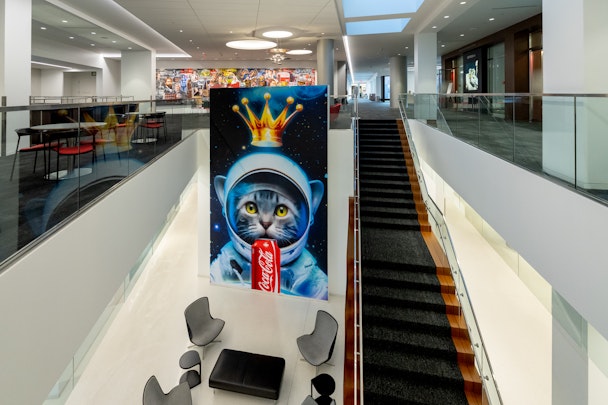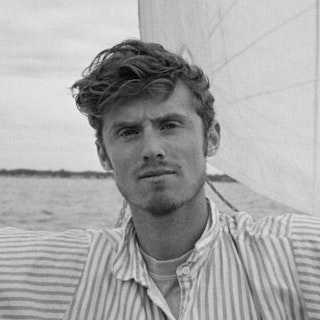Coca-Cola’s Pratik Thakar on the power and potential of generative AI
Days after the conclusion of its first-ever Real Magic Creative Academy, we catch up with Coke’s new global head of generative AI to find out how the brand is leveraging this technology to foster stronger connections with digital artists.

An AI-generated image graces the interior of Coke’s Atlanta headquarters. / Coca-Cola
Coca-Cola is pushing forward in its efforts to position itself as a creative pioneer in the emerging field of generative AI.
Last week, the company held its inaugural Real Magic Creative Academy, an event it described as a “creativity and generative AI innovation symposium.” The Creative Academy – an extension of both Coke’s recent AI-powered Create Real Magic contest and its broader Real Magic campaign – was hosted at the brand’s global headquarters in Atlanta from August 15-17.
Through the Creative Academy, Coke sought to build stronger ties with independent digital artists while simultaneously providing those artists with some of the skills that they might need in order to thrive in a marketing landscape that is continually experimenting with and embracing generative AI. The cohort of artists who participated in the three-day event – which included the winners of Create Real Magic – were allowed to tour the beverage brand’s archives, a giant room filled with some of the iconic artistic artifacts which have defined Coke’s brand identity and aesthetic over the course of its nearly 140-year history.
In addition to touring the archive, the Creative Academy participants met with representatives from tech giant Nvidia, management consulting firm Bain and Company and other prominent brands to discuss the far-reaching commercial and artistic implications of generative AI. The event also hosted “creative sessions” in which participants worked with fashion brands to work on “realistic creative briefs … and ideate with the brands on artwork that showcased the intersection of culture and fashion.”
Advertisement
Coke has a reputation for jumping enthusiastically on to new technological trends; it was quick to launch an NFT campaign in mid-2021, and it also jumped on the metaverse hype with an allegedly pixel-flavored soda. The Creative Academy is a strong signal that the brand fully intends to squeeze all of the marketing clout that it can out of generative AI, a technology that some marketers believe could usher in a complete paradigm shift for their industry.
To learn more about the goals behind the recent Real Magic Creative Academy and how that fits into Coke’s broader AI strategy, The Drum spoke with Pratik Thakar, the brand’s recently appointed global head of generative AI.
This interview has been edited for length and clarity.
Advertisement
What were the driving goals behind the Create Real Magic Creative Academy? Did everything go smoothly?
It went very well – we were super happy with the way it came together. Basically, the [big question behind the project] was: ‘How do we bring human beings and technology together?’ Coca-Cola has always bridged the divide, whether that’s social or geographical – Coke is Coke is Coke in every part of the world. We bring people together. So when we partnered with OpenAI, again, that was the whole idea: How can we bridge the divide when people are worried about new technology? How do we make it more approachable? How do we make it more palatable and something which is useful to everyone? We have been working with lots of technologists, creative designers and artists – how can we bring them together, bring them the best technology, bring them the most like provocative challenges and briefs?
Cola-Cola collaborated with Andy Warhol … [it] partnered with Haddon Sundblom, who created the way we see Santa today. We have always collaborated with artists, and we will keep doing that in the future. Now we have an opportunity where we can bring [artists] to our archive, show them what other artists have done using Coca-Cola as an inspiration, and then bring in AI technology.
Instagram made everyone an influencer, TikTok made everyone an entertainer and AI is making everyone a creator – you can be the artist now … Maybe one of these artists will be the future Andy Warhol. So that’s what the intention was – that’s why we brought people together. We wanted to democratize Coca-Cola and say, ‘Here, the brand is in your hands, play with it.’
Suggested newsletters for you
So the core idea was essentially to open-source Coke’s brand identity and aesthetic using AI?
We see Coca-Cola as the custodian of the brand, but [the] people are the owners – this brand is in their hands, which they are the owners end of the day. So that’s one of the big underlying ideas. Another one is that Coke can open up doors for individual creators. They’re not coming from big companies or from big agencies. They’re all individual artists; most of them are running a small studio or they’re working as freelancers. We wanted to empower that demographic because that’s where the creator economy thrives. The third idea is bringing together world-class [brands] like A Bathing Ape, Highsnobiety and Nvidia.
We looked at [the Create Real Magic Academy] as a developers’ conference … It’s not an academic exercise. This is the real world.
We’re living through a fascinating moment in which the marketing industry – and society more broadly – is both captivated by AI and slightly anxious about its implications. How do you approach balancing the benefits of AI with its risks?
No technology is perfect; self-driving cars aren’t perfect; rocket Science isn’t perfect. We need to maintain positivity but also make sure that we don’t [use these technologies] blindly. We have to ask: ‘What is ethical?’ That’s why we’re only using certain [AI] platforms – we work with those tech companies to make sure that their models are trained in the right way … [We] understand that every new technology will have both risks and opportunities – we want to focus on opportunities. We started with experimentation, but now we’re using [AI] across multiple marketing programs.
What are your responsibilities and goals as Coca-Cola’s newly appointed global head of generative AI?
Right now, [my priority is to] focus on consumer-facing technology and then create those experiences which can be scaled, which can help to build towards a marketing transformation for the company. The recent Real Magic Creative Academy is a perfect example – we brought our partners and different collaborators together to work on real-world briefs.
[My goal is to] bring a future-facing technology together with the best creators across the world and create this ecosystem. It’s not a one-stop shop… different creators coming from different parts of the world have different focus areas. Some are focused on computer vision, for example, others on text and others on images or videos. We need to work with all of them.
What were some of the big lessons you walked away with from the Create Real Magic Creative Academy? What would you like to do differently next time?
It was very encouraging. I would do it kind of three times larger in the future. Also, we were more focused on projects with six-month to a year [time horizons], but next time I would want to have a more long-term view – let’s say looking out five years. I would also scale it up to include more partners and more creators and allow them to work together … we’re connecting everyone and creating that thread.
The members who partook in the first Real Magic Academy will become the inspiration for future initiatives … During the last day, we wanted to hear everyone rather than just talk, and they all told us that they wanted to stay connected and to work on real projects together. These people will be a kind of lighthouse for the next [cohorts] to come through the Academy.
For more on the latest happenings in AI, web3 and other cutting-edge technologies, sign up for The Emerging Tech Briefing newsletter.

